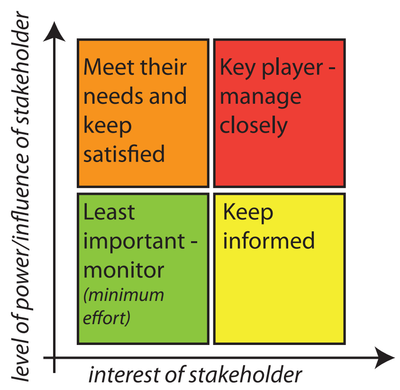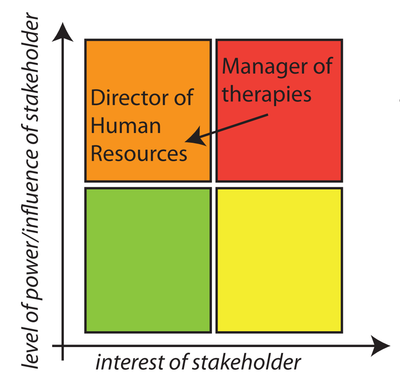Your success at both protecting your existing services and expanding them into new areas hinges on how receptive your stakeholders (e.g. CCG commissioners, local authority public health commissioners) are to listening to your case as much as how successfully you put across your case. If you have already established a positive relationship with your stakeholders, they are more likely to aware of your service and be open to hearing more about your plans and that’s half the battle! Neglect your stakeholders and they may actively work against you. On the other hand, manage your stakeholders well and they will actively promote you and your service.
What is a stakeholder?
It’s important to understand what a stakeholder is. There are many definitions but for this exercise the most suitable one is:
"Any group or individual who can affect or is affected by the achievement of your (or your organisation’s) objectives."
- Freeman (1984)
Identify your stakeholders
It is helpful to do this part of the exercise as a group and brainstorm using a pad of sticky notes and writing one stakeholder on each note. List everyone who affects or will be affected by your service – positively or negatively. The stakeholders of dietetic services are likely to be many! Below are some examples of the many stakeholders that you may identify.
Within your own organisation
These can include other members of the multidisciplinary team you work with and other people with whom you deliver a service, as well as those who are the decision makers that impacy your service. Examples include:
- Head of Service
- AHP Lead
- Nursing Director
- Communications Manager
- Chief Executive
Beyond your organisation
There are a huge range of people and organisations outside your own service that you may wish to influence. Examples include:
- Local government and NHS organisations, including commissioners, health boards, councils etc.
- National government or NHS/Health organisations, from Parliaments and Assemblies to bodies such as Public Health England or NHS Scotland.
- Patient bodies and charities, such as Age UK, Macmillan or Coeliac UK.
- Other professional bodies and trade unions, including medical royal colleges and other AHP bodies.
- The media, from local newspapers to specialist publications
- Industry, from big food companies to those manufacturing specialist nutrition products
Analyse your stakeholders
Now you have a list of people who you regard as stakeholders in your service. They can now be sorted according to their level of interest in you and your service on one axis and their level of power or influence on the other. This can be plotted on a matrix like the one below.

If you do then you may also wish to draw ‘arrows of influence’ between the stakeholders if you think that they influence one another. For example, draw an arrow from the Manager of Therapies to the Director of Human Resources if you feel that the former influences the latter, as in the matrix below.

You should now have your stakeholders organised into four broad categories:
- High power high interest people: these are the people your ‘key players’ - you must fully engage and make the greatest efforts to satisfy. Your approach is to ‘manage closely’.
- High power, less interested people: put enough work in to keep these people satisfied but do not bore them with excessive communication. Your aim should be to increase their level of interest in you and your service. Your approach is to meet their needs and keep them satisfied.
- Low power, high interest people: Your approach is to keep these people informed. These people can be useful. If they are interested in your area of work they may at some stage be tasked with working in it – keep informed, but don’t spend excessive time in doing so.
- Low power, less interested people: Your approach is to monitor these people but do not bore them with excessive communication. Your aim should be to increase their level of interest in you and your service.
Plan your stakeholder engagement
The key to successful stakeholder engagement and influencing is planning. How you engage and with what message you engage is determined by the stakeholders' position on the matrix. Successful engagement means communicating the right message using the right method.
Transfer the contents of your matrix into a table, focusing on the most important stakeholders first. For each stakeholder list the following:
- Name
- Engagement approach e.g. "Keep satisfied"
- Key interests - what are their motivations and priorities?
- Current status - are they a supporter or an opponent?
- What do you want them to do?
- What message do you want them to receive?
- Methods - what options do you have to communicate with them?
- Timeframes - how often and when are you going to communicate with them?
What message?
With the above information it should be easier to work out what messages make sense for which stakeholders. Make sure you strengthen your message as much as you can, and tailor it to each audience.
- Use or related your message to current research, national guidelines and clinical pathways
- Include data and evidence on the effectiveness of your service
- Show how your service or idea help them meet their priorities or specific targets
- Include patient stories and quotes.
- Use existing resources such as BDA Food Facts and Key Facts
- Make sure you include an ask or demand - what do you want them to do for you?
What method?
There are lots of different methods by which to deliver your message, but broad categories include:
- Push Methods: Push methods of communication can be made available to all stakeholders – these are one-way methods of communication. You are literally pushing your message out to your stakeholders. e.g. leaflets, letters, video, webpages etc.
- Pull Methods: Pull methods of communication are two-way methods and require the recipient to actively retrieve the message and involve themselves. (You are ‘pulling’ the stakeholder to the message.) e.g. presentations, social media, webinars, meetings
- Consultative methods: Consultative methods are a good way to involve and ask the opinions of people in the low power/ influence but high interest group – they will be keen to take part. It is also a good way to create interest in the high power/influence low interest group. e.g. questionnaires, focus groups.
What else can I do?
Don't be shy! Publicise the work that you are doing locally and nationally by:
- Send stories of success or your annual report to key stakeholders
- Present your successes at meetings and conferences
- Submit content to your trust newsletter or local publications, as well as Dietetics Today.
- Take every opportunity, including to deliver your Elevator Pitch!
- Respond to national calls for evidence or consultations.
- Get involved with the BDA!

